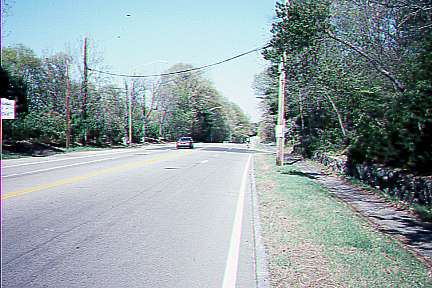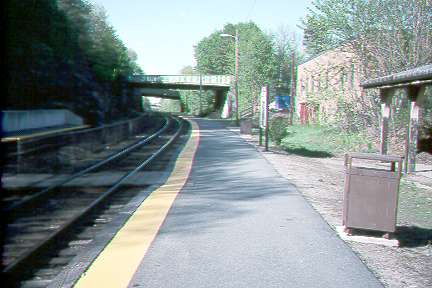
The town of Wellesley falls into several major sections:
a relatively low-density residential area north of Massachusetts Route 9;
an east-west central transportation spine, denser residential development and businesses along Route 9 and Washington Street, the only two through east-west streets;
Wellesley College in the triangle at the west bounded by Central Street, Washington Street and the town line;
more low-density residential development and much open land to the South, including Babson College, the Wellesley Country Club and several parks.
The major need to improve bicycle transportation routes in Wellesley is determined by Route 9 and Washington Street, both as they divide the town and through lack of alternate parallel east-west corridors in the Washington Street business district.
Several interesting possibilities for bicycle paths exist in Wellesley, particularly along two aqueduct corridors.
Route 9, a major, four-lane highway carries heavy, high-speed traffic and has many curb cuts. It is unpleasant, though it is rideable by experienced bicyclists, as it has wide shoulders. Most bicyclists will use Rte. 9 only when necessary to reach destinations along it; but to maintain access, its cross section should retain the shoulders in order to facilitate bicycle access to the many businesses and some residences along it. In some places, right turn lanes take up the space of the shoulder. Preferably, the highway would be widened a few feet at these places to allow bicyclists to travel between the through traffic and right-turning traffic.
Route 9's major effect on bicyclists is a barrier to north-south travel. Increase in traffic density and speed on this highway has been by accretion rather than by plan. Originally, Route 9 had a trolley line down the middle, and trolley passengers had to cross the vehicular travel lanes to get to and from the trolley cars at the numerous trolley stops, as is still the case on the remaining part of the trolley line on Huntington Avenue in Boston. Such crossings would now be unthinkable in Wellesley.
There are four grade separated crossings of Route 9 at Weston Road, Cliff Road, Washington Street and Cedar Street. There is a signalized crosswalk at Oakland Street, one just east of Cliff Road, and one at Kingsbury Street. There is also a signalized T intersection at Overbrook Drive. The low number of crossings of Route 9 confines north-south bicycle traffic to arterial and collector streets, denying the use of lightly used streets and lengthening local trips.
Replace the signalized crossing at Kingsbury Road with a bicycle-pedestrian overpass there or nearby to allow unimpeded and safe access between the neighborhood north of Route 9 and the junior high school, Washington Street business district and rail stations.
Construct another overpass on the Cochituate Aqueduct right of way near Morse's Pond, or else provide bicycle access to the south side of Route 9 at the Overbrook Drive traffic signals. The overpass alternative is more expensive but is consistent with a through bicycle path in the Aqueduct corridor. The traffic signal alternative is cheaper but may pose onwership problems. While the state highway section map shows Overbrook Drive extending south of the intersection, the right of way, if any, lies between two buildings of the Kehoe Ford dealership.
Washington Street (Route 16): has two major sections of different character. West of the intersection with Central Avenue, Washington Street is a semi-rural highway which passes Wellesley College and the golf course in an area with relatively few traffic generators. From Central Street to the east end of Wellesley, Washington Street mixes commercial with residential uses and a few sections of parkland.
On Washington Street west of Central Avenue, assure 14-foot lane or lane/shoulder width to accommodate bicycles. Washington Street narrows to the west of Wellesley College and as it continues into Natick. Any future reconstruction should include minor widening and shoulder striping to accommodate side-by-side bicycle/motor vehicle lane sharing.
From the Central Avenue intersection east, bicyclists have little choice but to use Washington Street to access the business district. Therefore, all reasonable attempts should be made to improve bicycling conditions on this street. The primary requirement is for travel lane width. Fortunately, Washington Street is rather wide; however, in the several sections where parking restricts travel lane width, it might be moved off-street. Intersection treatments should allow for a wide through lane, preferably accommodating pedestrian crossings by islands rather than neckdowns. Traffic signals and other traffic control devices should account for bicycle traffic.
Route 135 (Central Street): Abruptly changes from two wide lanes to four narrow lanes at the Natick-Wellesley line. Traffic capacity is in any case limited not by this section but by traffic signals and congestion at the intersection with Weston Road. Central Street includes entries only from Bacon Street, Pond Road and two Wellesley College entrances. The cross-section of four narrow lanes is bicycle-unfriendly, a special concern on a road adjacent to a college campus. Left turns are difficult in the face of high-speed traffic.
Route 135 changes from two lanes to four, looking east from Natick to Wellesley

Linden Street: Just north of the Conrail line, this street runs parallel to Washington Street for a few blocks, bypassing the heavy congestion in Wellesley Hills around the junction of routes 16 and 135. The west end of Linden Street makes an excellent connection with the Cochituate Aqueduct, and a number of cross streets provide access to Washington Street east of the congested Wellesley Hills area.
Restripe Central Street (Route 135) to two wide lanes with shoulders/bikelanes. Provide dedicated left turn lanes and perhaps traffic signals at Pond Road, Bacon Street and the Wellesley College entrances.
Preserve the usefulness of Linden Street for bicycling by avoiding width encroachments such as parallel parking. At the east end, where Linden Street is narrower, consider widening it, or perhaps use traffic-calming techniques to discourage through motor traffic. Examine the potential for a direct connection into the rail station at the east end of Linden Street. Design traffic signals to facilitate turns from Linden Street onto Washington Street eastbound.
Minor arterials and collectors south of Washington Street (Grove Street, Great Plain Avenue, Wellesley Avenue, Hunnewell Street, Oakland Street, Cedar Street): are generally wide and carry relatively light traffic due to the low residential density in this area.
Minor arterials and collectors north of Washington Street (Weston Street, Cliff Road, Glen Road): are of variable quality for bicycling. Cliff Road and Glen Road are relatively wide; Weston Street carried substantial traffic and is a bit too narrow for comfortable bicycle use at peak times.
On all minor arterials and collectors, preserve width from encroachment due to parking. Relieve narrow spots on all of these roads during routine repaving and reconstruction projects. Maintain them as two-lane roadways. Any intersection reconstructions should provide added width for turn lanes, rather than to restripe the roadway with substandard lanes. Keep speed limits moderate.
Provide alternatives, particularly for children and novice bicyclists through the suggested Kingsbury Street overpass (see under Route 9, above) and other local improvements to promote through bicycle travel on local streets. In the Boulder Brook Reservation/Kelly Memorial Park, which separates neighborhoods to its north and south, construct a path linking Westgate Road with Beverly Road to facilitate through bicycle travel without using Weston Street.
West of Weston Street, the Cochituate Aqueduct provides a right-of-way well-suited to a bicycle path. The aqueduct provides a connection to lightly-traveled roads leading to the Morse's Pond recreation and swimming area. The aqueduct has been abandoned by the MWRA, and belongs to the town of Wellesley.
Between Wellesley Town Hall and Abbott Street, the aqueduct is too broken up by cross streets -- including two crossings of Washington Street -- to be serviceable for through bicycle travel; however, portions of it may be useable as parkland and a walking trail.
From Worcester Street to the Charles River, the aqueduct has potential for parkland and for useful shortcuts to avoid Washington Street, but is interrupted by crossings of busy streets, and blocked at one end by Route 9, at the other by the Charles River and Route 128. A bicycle path along the Conrail right-of-way could connect this section with the western section of aqueduct and make a useful through route as far east as Washington Street (see below).
Improve the western section of the aqueduct as a bicycle path. Note: the cable barrier across Turner Road at Halsey Avenue should be removed, or replaced with bollards. A cable barrier is hard to see, and can cause a serious accident. A path turning to the south from the aqueduct corridor and continuing around to the west side of Morse's Pond could make a through connection via Shore Road to Oak Street in Natick. Another useful path would skirt the south side of Morse's Pond, connecting Turner Road with Bacon Street. This path would have to cross Bacon Street on the railroad bridge to avoid private property along Morse's Pond (see Natick report).
Another proposal has been to build an overpass where the aqueduct crosses Route 9, continuing a path to the north. See comments on Route 9, above.
With a few interruptions, for which practical detours on streets are available, the Sudbury Aqueduct provides a corridor from Echo Bridge on the Charles River in Needham through to Natick. There are relatively few cross streets and many scenic vistas. This aqueduct could also serve as a practical east-west bicycle travel corridor through southern Wellesley and northern Needham. The aqueduct is active; however, it is to be rebuilt, offering the opportunity to construct a pathway over it.
Examine and pursue the development of a path over the aqueduct, with on-road detours where needed to avoid repeated street crossings in close proximity (Hunnewell Ave and Oakland Street; Benvenue Road.) Special attention must be given to the safety of crossings of major streets, particularly Great Plain Avenue (just across the Needham line), Grove Street and Wellesley Avenue, so these crossings will be safe for use by children. Either signalization or a grade separation should be provided.
Riverside-Lower Falls rail spur: Connects the Riverside MBTA station with the East Wellesley-Newton Lower Falls area.
East-west rail line connector: From the east end of Linden street through to the aqueduct corridor east of Route 9, there is no alternative to Washington Street.
Improve the Riverside-Lower Falls spur as a bicycle-pedestrian path. Connect with the Ledyard Street neighborhood in Wellesley to provide access into North Wellesley without using the Washington Street corridor. Examine the possibility of a Charles River crossing south of Washington Street proceeding from the Concord Street (Newton Lower Falls) intersection to Walnut Street, as an alternative to steep River Street and the need for turns at its unsignalized intersection with Washington Street.
Examine the possibility of carrying a bicycle path from just west of Weston Street through the railroad corridor at the Wellesley Hills rail station to just east of Route 9 to join the aqueduct corridor. This proposal involves some serious right-of-way issues: however, there is room in the corridor, as the rail tracks are much farther apart than necessary to prevent trains from colliding. Suggested route: north of the tracks behind the rail platform, to avoid conflicts with passengers at the rail station; then crossing the tracks east of Route 9 (grade crossing with gates, or overpass/underpass).
Railroad corridor at Wellesley Hills railroad station
